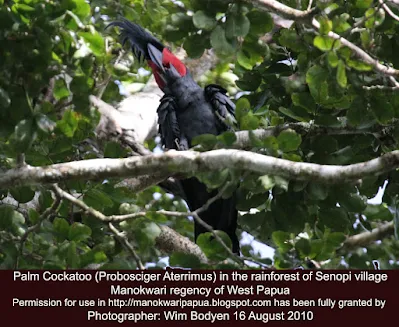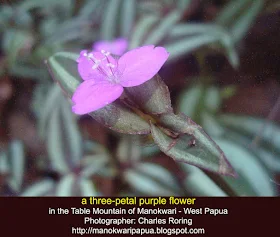Arfak Mountains in Papua are very rich of medicinal plants. There are herbs to cure malaria and a lot of other plants that can treat various kinds of diseases. In Kwau village of Arfak Mountains of Manokwari regency, there are two "herbs men" who like to guide tourists around the forest to study the medicinal merit of plants and flowers that are usually used by the indigenous Papuan to cure their illnesses. Their names are Samuel Mandacan and Yatinus Mandacan. I write this article to promote ecotourism scheme for Kwau village that is focused on attracting tourists who are interested in herbal medicine so that they can come to the village and study the tropical medicinal herbs from Arfak Mountains. Because of their isolated location, the indigenous Papuan who live in Kwau village have to rely on the plants around them for the treatment of their health. This tradition is now exposed to the world through this blog to help the Papuan preserve their rainforest and at the same time promote their traditional medication techniques that are unique to people like us who often rely on chemical medicines throughout our life.
 |
| White Medinilla Flowers |
I was in Kwau village of Arfak Mountains on 24 and 25 September 2010. I went there on the invitation of Hans Mandacan, an indigenous Papuan who is trying to develop eco-tourism for his village. I met him for the first time in late May 2010. I was speaking to Katja Zimmermann - a tourist from Germany when Hans Mandacan entered my bookstore. He was looking for a bible that is published in two languages, i.e. Bahasa Indonesia and English language. He needs the book to study English. Two days before that, Katja went to Arfak Mountains where she met Hans Mandacan. She introduced Hans to me. In our first meeting, Hans expressed his intention to develop ecotourism project for his Kwau village so that the villagers can also get the benefit which ecotourism gives for the tropical rainforest that covers the entire mountains inside the boundaries of their village territory. I didn't really pay attention to his idea because I know it is not easy to develop ecotourism for a village whose infrastructure is not adequate to receive tourists especially those who come from Europe. But Hans Mandacan kept coming to me for around seven times. At his first visits, I rejected or ignored him. He was not angry. Instead, he patiently was waiting for me while I was on a tour with Dutch tourists around the Table Mountain. Few days ago, he came again for the seventh time. This time, I thought I could not reject him anymore.
 |
| House of Hans Mandacan |
So, I went to Kwau village accompanied by Samuel Mandacan (the head of the village) and Hans Mandacan (the English speaking guide for the Kwau village). Hans arranged the car for me. I know that it's very expensive to go to Arfak Mountains and both the Arfak men showed their sacrifice to bring me there. It took one and a half hour to reach the place where the car could not go any further. We got out of the car, it was a Toyota 4WD Hilux, and began hiking along the pathway leading to Hans Mandacan's house. When we were walking along the ridge of the mountain under the canopy of the tropical trees, I could hear the sounds of streaming water far below us. On both side of the pathway, wild flowers were blooming. I don't know their names because I haven't seen them before. I took out my camera and took a lot of pictures of the flowers and various kinds of plants that looked interesting. It was drizzling when we were at around one kilometer from Hans' house. I covered my Sony digital SLR camera with plastic bags to protect it from the rain. Forty minutes later we reached the house. Hans had built a concrete house near his traditional kaki seribu house - fully made of wood. Both of them looked very contrast. I was amazed to hear that Hans carried thousands of bags of sand from the ravine one kilometer from where the house is. I was very tired because I didn't sleep the previous night. I requested permission from Hans Mandacan that I needed to take a rest for around 1 hour before I could start to explore the surrounding area. The temperature was so cool during the day. Fog covered the house and the whole forest but then it was clear again. After eating lunch, I decided to make a small tour to the ravine.

I was accompanied by Samuel Mandacan and Apolos and two of Hans' children. Samuel showed much interest in explaining the medicinal merit of the green plants that we saw. He said that long before the modern medicine was introduced to Kwau village by health workers from the government, their ancestors had used various plants in the Arfak mountains to cure diseases. He pulled a plant. In local language, its name is Ntam. Samuel said that the flower of the plant is usually used to kill bacteria and skin fungus that cause various skin diseases. The person who suffers from a skin disease only rubs the flower of the Ntam plant on the surface of his or her skin. The treatment should be carried out every day until the skin gets well again. Within one or two weeks the skin will look healthy after being treated by the flower of Ntam. In addition to the flower, its leaves are very effective in curing people who suffer from Malaria. The extract of the leaves is used to restore the body temperature to normal level when the patient experiences high fever. For children the safe dosage is a half glass of Ntam leaf extract whereas for adults, one full glass of the extract is recommended.
 |
| Hans Mandacan and his family |
Eco-tourism activities which tourist can enjoy in Kwau are many. While hiking in the forest that produces fresh air, tourists can study the medicinal merit of a lot of species of tropical plants that live in the rainforest. Samuel Mandacan as the "herbs man" and Hans Mandacan -the interpreter will guide you around to show you the herbs. You can also try the medicine with the supervision of Samuel to ensure that the herbs that you drink is safely processed and measured according to the hundreds of years of tradition of the Kwau tribe.
NATURE TOUR IN THE HIGHLAND OF MINAHASA
Minahasa highland is a region in the Province of North Sulawesi whose landscape consists of volcanoes, hills, valleys, lakes and rivers. It is a highly recommended destination for tourists who are nature lovers.
Sulawesi is an island in transitional zone between Asia and Australia. The endemism of fauna is very high.
For North Sulawesi, Sonder town is the destination for visitors who want to explore nature both its flora and fauna. Birdwatching or wildlife watching could easily be done along the roads and walking paths that go through farmlands of Sonder.
 |
| Birdwatching in Sonder town of Minahasa Highland |
In Sonder town and its surrounding areas, birdwatchers could find such birds as Sulawesi Cuckoo Dove, White-faced Cuckoo Dove, Zebra Dove, Collared Kingfisher, Black-crowned White-eye, Yellow-sided Flowerpecker, Gray-sided Flowerpecker, Pale Blue Monarch, Chestnut Munia, Scaly-breasted Munia, Turquoise Flycatcher, Black-naped Oriole, Sahul Sunbird, Finch-billed Myna, Hair-crested (White-eyed) Drongo, Crimson Sunbird, Mountain White-eye, Black-faced Munia, Sulawesi Pygmy Woodpecker, White-breasted Woodswallow, White-browed Crake, Cattle Egret, Little Egret, Barn Swallow, White-nest Swiftlet, and a lot more.
 |
| Pale Blue Monarch |
As a birdwatching guide, I often organize tour for birding visitors. I bring binoculars, spotting scope and laser pointer as well as portable loudspeaker to enhance the birding experience of the visitors.
For field guide book, I use Birds of the Indonesian Archipelago: Greater Sundas and Wallacea by James Eaton et al.
To enjoy birdwatching and nature tour holiday in Minahasa highland, visitors need to fly from their country to Indonesia. Transit point can be Singapore where the next flight could be done by Scoot Air to Manado city or major cities in Indonesia such as Jakarta, Surabaya and Denpasar. There are daily flights to Manado city provided by Lion Air, Batik Air, Garuda and Trans Nusa to Manado city. I could meet you at the airport and organize your trip to Manado city.
 |
| Flying routes to Manado city |
Besides watching birds, visitors could see Minahasan farmers work in their farmlands. Or visit Mount Mahawu, Love Hill to see the magnificent landscape of Minahasa highland.
 |
| Nature Trip in North Silawesi |
The highland of Minahasa is the habitat of a lot of species of butterflies such as Blanchard's Tree Nymph Butterfly, Blanchard's Wood Nymph butterfly, Manado Yellow Tiger Butterfly, The Sulawesi Clipper Butterfly, Helena's Birdwing Butterfly and etc.
 |
| Wood Nymph Butterfly in the forest of Sonder town of Minahasa Highland |
If you are interested in taking a nature tour, you could contact me by email to: peace4wp@gmail.com or by whatsapp to: +6281332245180, I will be happy to arrange your trip to this region. by Charles Roring.
Also read:












































